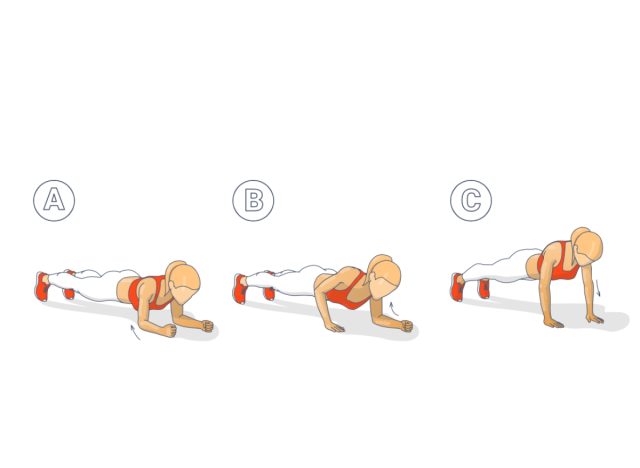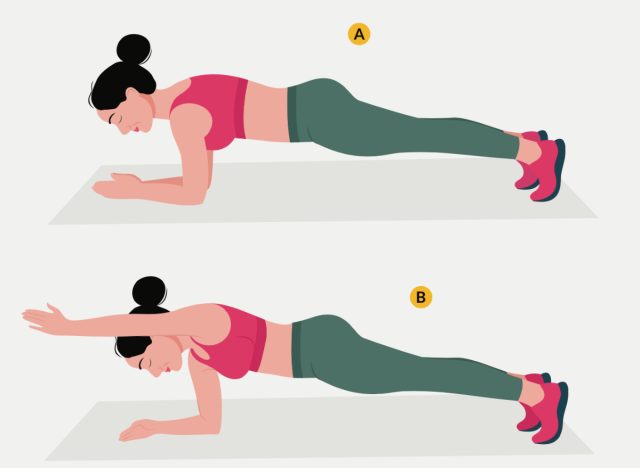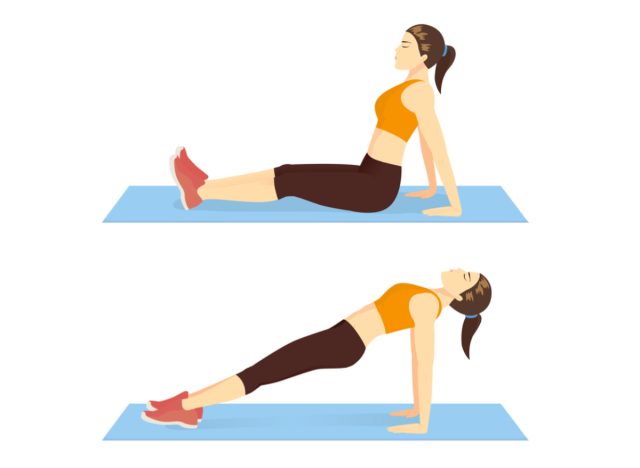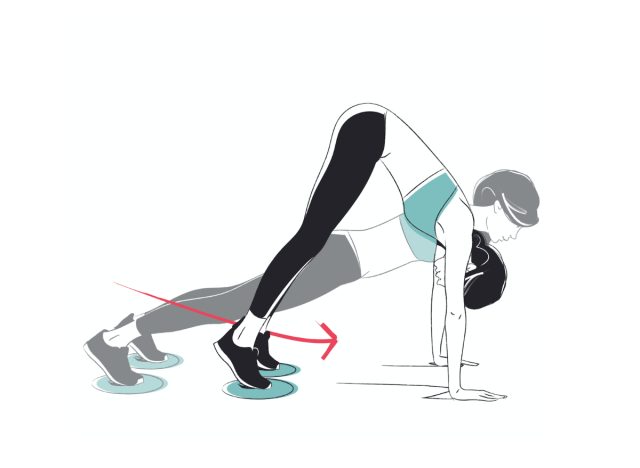Building a well-defined six-pack involves more than just doing traditional crunches and sit-ups. One highly effective exercise for sculpting your abs and enhancing core stability is the plank. By integrating different plank variations into your exercise regimen, you can focus on different areas of your core, boost muscle activation, and work towards achieving those coveted six-pack abs.
Below are 10 of the best plank variations I recommend to help my clients develop a lean and toned midsection.
The Workout

What you need: A yoga mat and, for some variations, a set of light dumbbells
The Routine:
- Standard Plank (3 sets of 30 to 60 seconds)
- Plank with Shoulder Tap (3 sets of 15 reps per side)
- Plank to Push-Up (3 sets of 10 reps)
- Side Plank (3 sets of 30-45 seconds per side)
- Plank Jacks (3 sets of 20 reps)
- Plank with Arm Reach (3 sets of 12 reps per side)
- Side Plank with Leg Lift (3 sets of 10 reps per side)
- Plank with Hip Dip (3 sets of 15 reps per side)
- Reverse Plank (3 sets of 30-45 seconds)
- Plank to Pike (3 sets of 12 reps)
Standard Plank

The standard plank targets the entire core, building a strong foundation for other plank variations.
- Start in a forearm plank position with your elbows directly under your shoulders.
- Keep your body straight from your head to your heels, engaging your core and glutes.
- Hold the position, focusing on maintaining a neutral spine and steady breathing.
Plank with Shoulder Tap

This exercise adds instability, engaging the core, shoulders, and obliques for improved balance and coordination.
- Start in a high plank position with your hands directly under your shoulders.
- Lift one hand to tap the opposite shoulder while keeping your hips stable.
- Alternate sides, maintaining core engagement throughout.
Plank-to-Pushup

The plank-to-pushup combines core strength with upper-body work, engaging the chest, shoulders, and triceps.
- Start in a forearm plank position.
- Push up onto one hand, then the other, transitioning into a high plank.
- Lower back down to your forearms and repeat, alternating the leading hand.
Side Plank

The side plank focuses on the obliques, improving lateral core strength and stability.
- Start in a side plank position with your elbow directly under your shoulder and your feet stacked.
- Keep your body in a straight line, engaging your core and glutes.
- Hold the position, then switch sides.
Plank Jacks

Plank jacks incorporate cardio into your plank routine, burning calories while strengthening the core.
- Start in a high plank position with your hands under your shoulders.
- Jump your feet out wide, then back together, similar to a jumping jack motion.
- Maintain a steady pace, keeping your core tight throughout the exercise.
Plank with Arm Reach

The plank with arm reach challenges your stability and core control, particularly the shoulders and lower back.
- Start in a high plank or forearm plank position.
- Extend one arm straight out before you while keeping your hips level.
- Hold for a moment, then return to the starting position and repeat on the other side.
Side Plank with Leg Lift

The side plank with leg lift intensifies the side plank, targeting the obliques and outer thighs for a more challenging workout.
- Start in a side plank position.
- Lift your top leg as high as you can, keeping it straight and controlled.
- Lower your leg and repeat before switching sides.
Plank with Hip Dip

The plank with hip dip enhances oblique engagement and adds a dynamic element to the standard plank.
- Start in a forearm plank position.
- Slowly dip your hips to one side, then return to the center.
- Dip to the opposite side and continue alternating.
Reverse Plank

The reverse plank strengthens the lower back, glutes, and hamstrings, complementing traditional plank exercises.
- Sit on the floor with your legs extended and your hands behind you, fingers pointing forward.
- Lift your hips toward the ceiling, forming a straight line from head to heels.
- Hold the position, keeping your core and glutes engaged.
Plank to Pike

This exercise combines core stability with flexibility, engaging the abs and lower back.
- Start in a high plank position.
- Lift your hips toward the ceiling, forming an inverted “V” shape.
- Lower back to the plank position and repeat, maintaining control throughout.
Frequently Asked Questions (FAQs) About Plank Variations for a Lean, Mean Six-Pack
What are the benefits of doing plank variations?
Plank variations are an excellent way to engage multiple muscle groups in your core, including the rectus abdominis, transverse abdominis, and obliques. They help improve core strength, stability, and endurance, leading to better posture, reduced risk of back pain, and overall improved athletic performance.
How often should I include plank variations in my workout routine?
It is recommended to incorporate plank variations into your workout routine 2-3 times a week for optimal results. Make sure to allow for proper rest and recovery between plank sessions to prevent injury and allow your muscles to repair and grow stronger.
Are plank variations suitable for beginners?
Yes, there are plank variations that cater to all fitness levels, including beginners. It’s essential to start with basic plank variations and gradually progress to more challenging ones as your core strength improves. Always prioritize proper form and technique over the duration of the plank.
How long should I hold each plank variation?
The duration of holding each plank variation depends on your fitness level and experience. Beginners may start with holding each plank for 15-30 seconds and gradually increase the duration as they get stronger. Advanced individuals can aim for 60 seconds or more per plank variation.
Can plank variations help me achieve a six-pack?
While plank variations are excellent for strengthening and sculpting your core muscles, achieving a six-pack also requires a combination of a calorie-controlled diet, overall body fat reduction, and consistent cardiovascular exercise. Including plank variations in your workout routine can contribute to improved core definition when combined with a healthy lifestyle.






